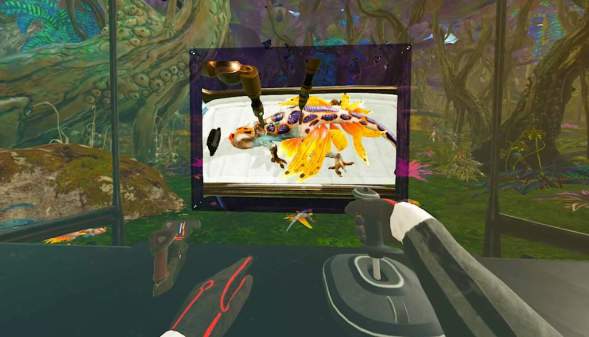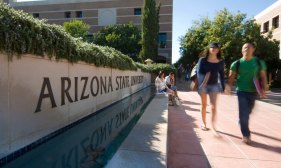An ‘infinite’ plan for higher ed: Q&A with ASU President Michael Crow

Michael Crow has earned a reputation in higher education as something of a visionary when it comes to technology and innovation.
The president of Arizona State University (ASU) — a large research institution located in Tempe, Arizona, but with an increasingly global student body, thanks to the explosion of online education — has overseen the school’s transformation into the most innovative college in the U.S., beating out the likes of Stanford and MIT.
During his nearly 16 years as president, Crow has developed a few defining philosophies. One is that technology is, in his words, ASU’s “special friend.” Another is that ASU should “spare no expense” when it comes to technological investment and experimentation. A third, based largely on the first two, is that “whatever technology is necessary, we acquire.”
What that looks like in action is an entirely new kind of higher education institution — ASU calls itself a “New American University,” in fact — whose students can be anyone, anywhere, at any time.
EdScoop sat down with Crow at the recent ASU+GSV Summit — co-hosted by the university and the investment firm Global Silicon Valley (GSV) — in San Diego to find out how he plans to continue investing in and scaling technology at ASU.
The following interview has been condensed and edited for clarity.
EdScoop: How is ASU setting its investment priorities around technology, both to meet its mission and to equip faculty members to teach in an increasingly technology-focused world?
Michael Crow: So, we have a three-word, very simple model for our investments in technology. It’s called “spare no expense.” And so, what’s happened to us is that technology has become the means by which we can more rapidly achieve all of our goals than any of our traditional approaches.
So, we’re spending everything that we can to enhance our technological capability, to get the highest speed, transmission, storage, whatever, so that we can have every student, every faculty member, every visitor, on three or four devices simultaneously logged on, you know, multiple video interactions, multiple interactions of communication.
Basically, for us, it’s whatever is necessary to empower the technological model.
And then, relative to the faculty, the issue for us there is digitally training them. We have 3,600 faculty members, and over 2,000 of them have been trained to interact and teach and create teaching and learning environments digitally.
That’s a big deal for us, with thousands of courses, hundreds of thousands of learners that we didn’t have just a few years ago. Our library is now used by people from 150 countries. We have learners from 195 countries right now who are engaged with us.
So, for us, it’s like technology is, I don’t want to say “it,” but technology is almost “it.”
Our on-campus outcomes, our student diversity, our financial models, the cost of the state to produce a degree is now reduced by 75 percent. All of these things are becoming transformative.
ES: So, when you go around and share that with other university leaders, what are the biggest hesitations or even objections that you hear?
MC: Well, academics object to everything. I was one of the provosts at Columbia University for more than 10 years. I was a faculty member there. We just argued all the time that I was there, and it was fun. I mean, I loved it. It’s fantastic, arguing on everything. Was Plato an idiot, was Plato not an idiot?
But, to your question, are people reacting to this kind of stuff? Possibly the answer is yes, but not everybody. So, what’s happening now is that you’re witnessing the emergence of new kinds of institutions. So, [Eloy Oakley, chancellor of the California Community College System] is advancing a new kind of community college, we at ASU have advanced a new kind of university. There are other smaller colleges here and there, and different things that have formed.
If you look back at education, what’s happened in American history is that through various points in time, new kinds of institutions have been born. So now California has asked Eloy to lead this effort to build this infinitely scalable community college that services all of the community. We’ve been asked to build what we call “The New American University.” And so, we’re a new kind of school.
Just look at our charter: “ASU is a comprehensive public research university measured not by whom it excludes, but by whom it includes and how they succeed.” Well, that’s different. You can’t do that without technology. It’s impossible.
So you’re literally going to infinite scale, which is any learner, anywhere, anytime can connect to this community college. No one’s ever done anything like that. The closest we’ve ever come to that is radio. … What I mean is there’s this ubiquitous signal that’s just out there for anyone to pick up on.
ES: How do you channel that into your IT investment strategies, some of the challenges you must face? Obviously the cloud makes this easier.
MC: The cloud makes it unbelievably easier.
ES: But there’s also so many competing technologies, there’s a lot of siloed technologies, there’s a lot of security issues around those playing together. What are your biggest concerns about having the technology to keep up with that vision?
Michael Crow: So, for us, we decided some time ago that technology was our special friend, that it had immense capacity to change our structures, our culture, our design, if we approached it carefully and judiciously.
And, so, we’ve gone all out at all levels — whatever technology is necessary we acquire, whatever is needed, whatever tools, whatever backup, whatever backbone, whatever storage, whatever speed, anything.
For us, what we’ve found is it’s cheaper than buildings. It’s cheaper than the traditional way that the institution advances. Yes, it seems expensive if you say to somebody, “Go ahead and spend $40 million upgrading our Wi-Fi networks.” Yeah, OK, compared to what? And, so, with those Wi-Fi networks, now we have self-assembled classrooms that are able to meet anywhere, we have students that are now teaching each other using unbelievable tools, we’ve got ways in which things are advancing.
And then, on top of that, we have a group called EdPlus at ASU. That group now has 170 technology partners. So, we started this meeting — what is now the ASU+GSV Summit — nine years ago with 100 people in a room in Scottsdale, Arizona. Now, we’ve got 4,500 people that are here for this meeting. Nearly all of the deals that we have made have come from these interactions. So, we have ways to read transcripts and evaluate them with robots. We have intelligent tutor robot systems. We have the first fully accredited online electrical engineering degree in the world. How do you build that, with a 65-member, research-intensive faculty? … The only way you can do any of that is technology.
So, we now have inherited students that are what I call “Millennial.nets.” They’re millennials, but they’re different than the original millennials because they have never lived without the internet. So, they’re coming in, fully expecting access to everything, like, “Why aren’t all the lectures online?” “Why can’t I react to the lecture by coding it as to what I understand or don’t understand?” So, we built that, we’ve deployed that.
We have online tutoring. We have intelligent-based tutoring. We have game-based career planning for high school students, with more than 150,000 users of that. You can get on this thing, answer 60 visual questions, just picking one picture over another picture, and it will have about a 95 percent chance of picking what your job interests are, and then we’ll plot you as a high school student, to what you need to do in high school to be able to move in that direction.
So, whatever technology is necessary to be able to support a system like that, at infinite scale, is what we do.
For us, it’s like, what do you got? What do you have that we need? We’ve been a little frustrated on the artificial intelligence side. We haven’t found any tools that can actually do what they say they can do. And so, we get frustrated by that because there’s too much hype here and there, but nonetheless we’re working with all the big providers. We just made a big purchase of Salesforce; we’re the largest user of Salesforce. And we’ve made other purchases, other things that we’ve been doing. And so for us, it’s like, what’s needed?




